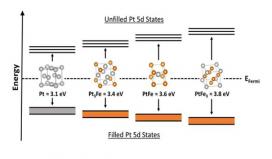New Spectroscopy Technique Offers Insight into High-Performance Catalysts
Purdue University researchers and scientists at Argonne National Laboratory demonstrated a new two-photon spectroscopy, offering new insight into high-performance compositions for reactions. Their work was supported by the Center for Innovative and Strategic Transformation of Alkane Resources (CISTAR), based at Purdue and an NSF-funded Engineering Research Center (ERC).
The new characterization technique and theory established that promoters in alloy nanoparticles lead to changes in the energy of valence orbitals, the outermost electrons in an element’s atoms that determine its chemical and physical behavior. The experimental validation by the new modeling approach will help researcher develop new compositions that perform better in catalytic reactions.
Spectroscopy that helps explain catalytic materials and processes is among the most active research areas in the study of catalysis. The technique developed at CISTAR will help characterize materials and study how their electronic structure changes during catalytic reactions. Improving the efficiency and reducing the costs of catalytic materials and reactions can benefit processes that are crucial to the production of about 90% of manmade chemicals.



